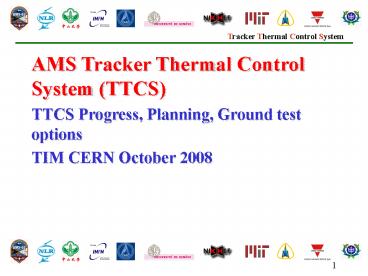AMS Tracker Thermal Control System TTCS - PowerPoint PPT Presentation
1 / 17
Title:
AMS Tracker Thermal Control System TTCS
Description:
Hydraulic connectors welding ... Brittle connectors Thermocoax wire heaters ... Connector positioning sensitive to vibration and handling damage. TTCS ... – PowerPoint PPT presentation
Number of Views:101
Avg rating:3.0/5.0
Title: AMS Tracker Thermal Control System TTCS
1
AMS Tracker Thermal Control System (TTCS) TTCS
Progress, Planning, Ground test options TIM CERN
October 2008
2
TTCS presentations
- Presentations
- NLR Overall progress, Accumulator repair status,
TTCS GSTTCS, Schedule J. van Es - INFN/AIDC HX Condenser, transport tubing
(presented by INFN) Elisa Laudi - SYSU EM Sec loop 3D testing, QM condenser testing
Zhenhui He - AIDC Box integration and preparations, DrJ Sun
- INFN/MIT TTCE G. Alberti /(M. Menichelli, V.
Koutsenko/L. Accardo/A. Lebedev)
3
Contents
- Overall progress
- Accumulator repair status
- GSTTCS Ground test options
- Mini-TTCS during beam testing
- Air-cooling at KSC (alternative for beam testing)
- Cold plate investigations
- TTCS Planning Integration activities on AMS02
4
TTCS Overall Progress
- Components progress
- Evaporators
- Hydraulic connectors welding finished
(NIKHEF/UniGe) - Cleaning evaporators (this week A. Pauw NLR)
- Transport tubing waiting for installation
- Bending, installationwelding planned second half
January 2008 at CERN - Condensers (details by INFN/AIDC)
- Most critical step successfully completed
(brazing manifolds)
5
TTCS Overall Progress
- Components progress
- TTCB Component boxes (SYSU/NLR/AIDC/INFN)
- Mechanical parts finished or in production
- Further details in AIDC presentation
6
TTCS Progress Overview
- Accumulator repair
- QM wire heater broken due to
- Brittle connectors Thermocoax wire heaters (0.5
mm diameter) - Also problems with pre-heater wire heaters were
found - Connector positioning sensitive to vibration and
handling damage
QM location of fracture
FMs sensitive to vibration and handling damage
7
TTCS Progress Overview
- Accumulator repair decision (consultation with
Tracker and NASA) - Replacement of all QM and FM wire heaters by 1 mm
wire heaters (more robust) - Vibration proof connector location
Replace by one wire
8
TTCS Progress Overview
- Accumulator repair actions
- Accumulator heater wire design (NLR) finished
- Manufacturing copper TS saddles (NLR) 30-10-2008
- Soldering and de-soldering preparation and test
runs (NLR) - Heat pipe emptying, extension welding,
vacuumizing, sealing (CAST) (finished) - Liquid inlet tube cutting (CAST) (finished)
- De-soldering, cleaning and re-soldering of the
wire heaters around the accumulator heat pipe
(NLR performed at SYSU) (17-21 November) - Heat pipe filling and sealing (CAST)
- Integration in TTCBs (AIDC)
9
TTCS Progress Overview
- Other important tasks
- TTCS EM testing (see presentation Zhenhui He)
- TTCS functional check Embedded S/W development
(presentation Gabriele Alberti) - MLI detailing on-going by CGS NLR
- TVTB LSS test preparations
10
TTCS Progress Overview
- Other important tasks
- Dynamic Model to test TTCE S/W (by D.C. Mo)
- Debugged and improved the dynamic model by INFN
- Added/Implemented accumulator model
- Model is running real time
- Comparison with Sinda-Fluint is acceptable,
however better verification with exact similar
boundary conditions needed - Generation C tested
- Next steps
- Dynamic model I/F definition with TTCE
- Generation C code
- TTCE S/W verification
11
TTCS ground test options
- TTCS cooling during beam testing
- Beam test prior to TV-testing ? Mini TTCS only
using evaporator and transport tubing - TV-test prior to beam test ? TTCS is integrated
and closed during beam testing - Option 1 Air cooling but limited Tracker power
so cooling air above dew-point is
sufficientAdvantage Simple design, little
impact on Flight H/WDisadvantage 50 of
Tracker power - Option 2 Cold plate attached to Tracker
radiatorsAdvantage Larger power Disadvantage
More complex (contact pressure, sensitive paint)
12
Mini TTCS during beam testing
- Mini TTCS
- Full power Tracker possible
- Tracker operation set-point at 20C to
23 C - Easy implementation
Connection points mini-TTCS
13
Mini TTCS during beam testing
- Mini TTCS as used during Tracker testing
(re-use 75)
valves deleted (not needed)
Clean pump Procured and available at NLR
Ground Support TTCS adaptations
14
TTCS ground test options
- TTCS cooling during (beam) testing, ESTEC KSC
tests - Option 1 Air cooling but limited Tracker power
so cooling air above dew-point is
sufficientAdvantage Simple design, little
impact on Flight H/WDisadvantage 50 of Tracker
power
15
TTCS ground test options
- TTCS cooling during (beam) testing, ESTEC KSC
tests - Option 1 Air cooling but limited Tracker power
so cooling air above dew-point is sufficient - Actions taken
- High set-point 26 C test to increase the
possibility of higher air cooling temperature
(see SYSU presentation)? yes possible - Calculations (SYSU) with reduced power show
feasibility. However still full radiator surface
is required. - DT condenser to radiator surface (of course
not a uniform straight forward answer ? further
research)
16
TTCS ground test options
- TTCS cooling during (beam) testing, ESTEC KSC
tests - Option 2 Cold plate attached to Tracker
radiatorsAdvantage Full power operation
Disadvantage More complex mechanics and
facility to avoid condensation - Actions taken
- Paint sensitivity test (G. Ambrosi)
- To be done
- Investigate contact pressure possibilities in
combination with interface filler
17
TTCS Planning































